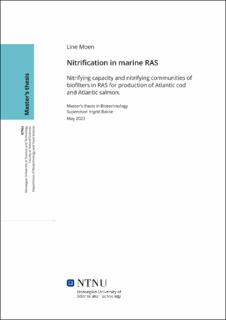| dc.contributor.advisor | Bakke, Ingrid | |
| dc.contributor.author | Moen, Line | |
| dc.date.accessioned | 2023-07-20T17:20:27Z | |
| dc.date.available | 2023-07-20T17:20:27Z | |
| dc.date.issued | 2023 | |
| dc.identifier | no.ntnu:inspera:140106117:98784705 | |
| dc.identifier.uri | https://hdl.handle.net/11250/3080583 | |
| dc.description.abstract | I denne masteroppgaven ble nitrifiseringskapasitet, sensitivitet for salinitet og de mikrobielle biofilmsamfunn i biofiltre operert ved høye saliniteter undersøkt. Lab-skala batch-eksperimenter ble utført med biofilm bærere fra to kommersielle RAS: en for produksjon av atlantisk torsk ved 35 ppt salinitet og en som for produksjon post-smolt av Atlantisk laks ved 15 ppt. Videre ble sammensetningen av de mikrobielle samfunnene i biofilmprøver fra tre ulike kommersielle RAS med høy salinitet undersøkt. Havlandet har et RAS som produserer atlantisk torsk ved 35 ppt, og Erko har et RAS som produserer post-smolt ved 15 ppt, hvor begge bruker moving-bed biofilm reaktorer. Lerøy Belsvik har et RAS som produserer post-smolt ved 22 ppt, hvor de bruker en fixed-bed biofilm reaktor.
Illumina-sekvenseringen viste at Nitrospira og Nitrosomonas var de viktigste nitritt- og ammoniumoksiderende bakteriene, hvor Nitrospira dominerte de bakterielle nitrifiserende samfunnene, og ASVer som representerte Nitrospira var de viktigste bidragsyterne til forskjellen i sammensetningen av biofilmsamfunnene mellom anleggene. Biofilm bærerne fra Erko viste overlegen nitrifiseringskapasitet, med en makskapasitet på 0.12 mg/L min ,og hadde både tre ganger så høy nitrifiseringskapasitet og relativ mengde nitrifiserende bakterier enn biofilm bærerne fra Havlandet. Kapasiteten til bærerne fra Erko ble opprettholdt både ved 31 ppt og i ferskvann. Nitrifiseringskapasiteten ble redusert med 50% i ferskvann for biofilm bærerne fra Havlandet, sammenlignet med brakk- og sjøvann.
En liten mengde ammoniumoksiderende bakterier ble funnet i biofilm-prøvene, noe som indikerte at ammoniumoksiderende arker kan bidra til oksidering av ammonium. Arkesamfunnene i biofilm-prøvene fra Havlandet og Erko var fullstendig dominert av en ASV som representerte Nitrosopumilus, en arke kjent for å oksidere ammonium. En annen ASV, som også representerte Nitrosopumilus, dominerte arkesamfunnet i biofilmprøvene fra Belsvik. Sanger-sekvensering og qPCR bekreftet tilstedeværelsen av en amoA-gensekvens i prøvene fra Havlandet og Erko som var identisk den en tidligere rapportert Nitrosopumilus oxyclinae. Resultatene indikerte også tilstedeværelsen av flere amoA-gensekvenser i prøvene fra Belsvik. | |
| dc.description.abstract | In this master thesis, the nitrifying capacity, salinity tolerance, and microbial biofilm community composition of biofilters operated at high salinities were investigated. Lab-scale batch experiments were conducted with biofilm carriers from two commercial RAS: one cultivating Atlantic Cod at 35 ppt and one cultivating post-smolt at 15 ppt. Furthermore, the microbial community compositions of biofilm samples from three different commercial RAS operated at high salinities were investigated. Havlandet has a RAS operated at 35 ppt for the production of Atlantic cod and Erko has a RAS operated at 15 ppt for the production of post-smolt of Atlantic salmon, both using moving-bed bioreactors. Lerøy Belsvik has a RAS operated at 22 ppt for the production of post-smolt, using a fixed-bed bioreactor.
Illumina sequencing showed that Nitrospira and Nitrosomonas were the most important NOB and AOBs, with Nitrospira dominating the bacterial nitrifying communities, and ASVs representing Nitrospira were the most significant contributors to the difference in the biofilm community composition between the facilities. The biofilm carriers from Erko showed superior nitrification capacity with a max capacity of 0.12 mg/L min and had both a three times higher nitrifying capacity and relative abundance of nitrifiers than the biofilm carriers from Havlandet. The capacity of the Erko carriers was maintained both in 31 ppt salinity and in freshwater. The nitrifying capacity was reduced by 50% in freshwater for biofilm carriers from Havlandet, compared to brackish and seawater.
A low abundance of AOB was found in all biofilm samples, indicating that AOAs might contribute to ammonia oxidation. The archaeal communities in the biofilm samples from Havlandet and Erko were entirely dominated by one ASV representing Nitrosopumilus, known to oxidize ammonia. Another ASV, also representing Nitrosopumilus, dominated the biofilm communities in samples from Belsvik. Sanger sequencing and qPCR confirmed the presence of an amoA gene sequence in the samples from Havlandet and Erko that were identical to a previously reported for Nitrosopumilus oxyclinae. The results from Sanger sequencing indicated the presence of multiple amoA gene sequences in samples from Belsvik. | |
| dc.language | eng | |
| dc.publisher | NTNU | |
| dc.title | Nitrification in marine RAS: Nitrifying capacity and nitrifying communities of biofilters in RAS for production of Atlantic cod and Atlantic salmon | |
| dc.type | Master thesis | |
